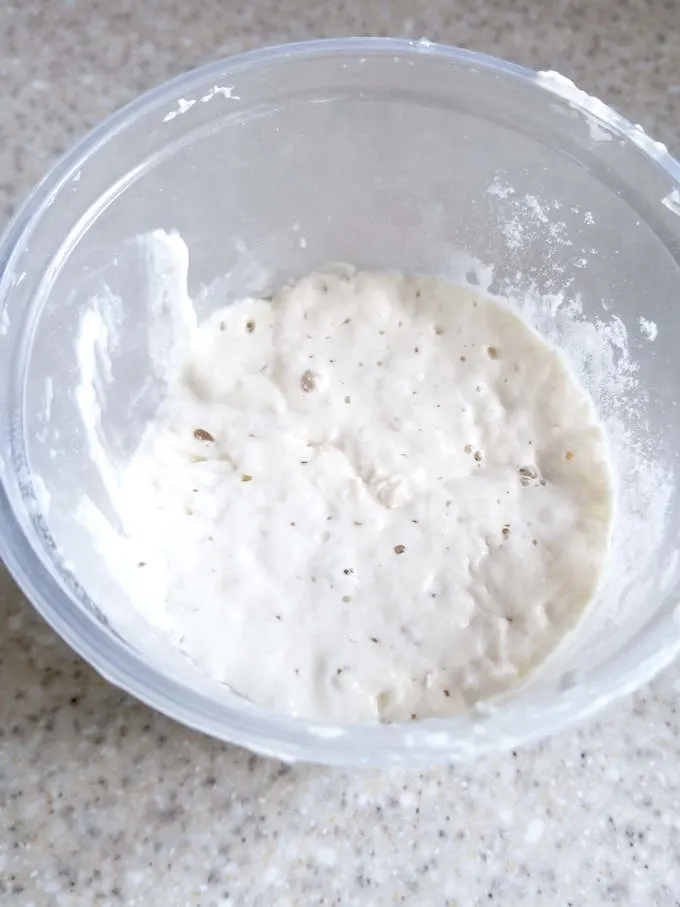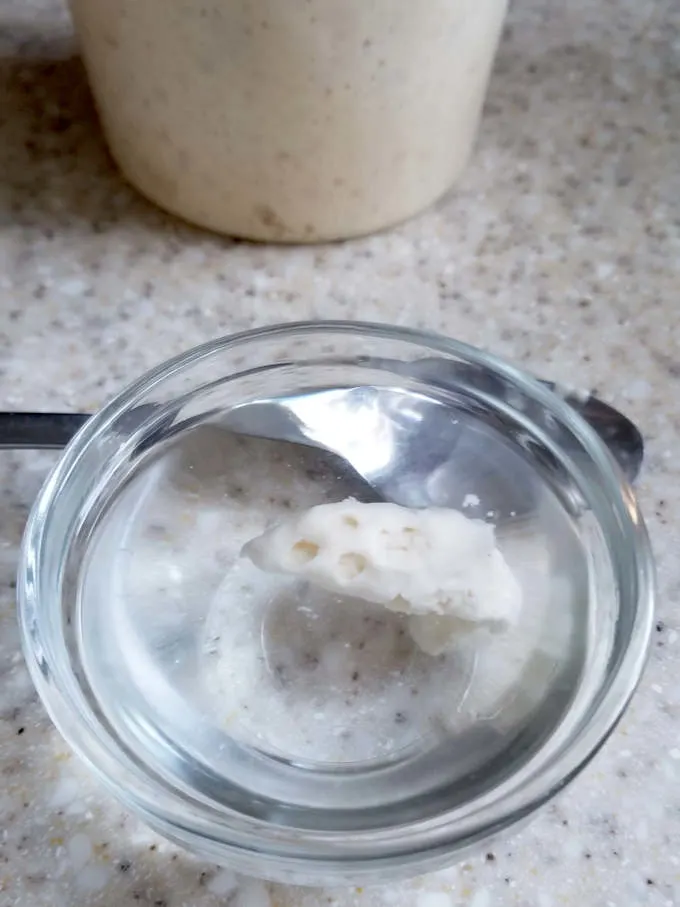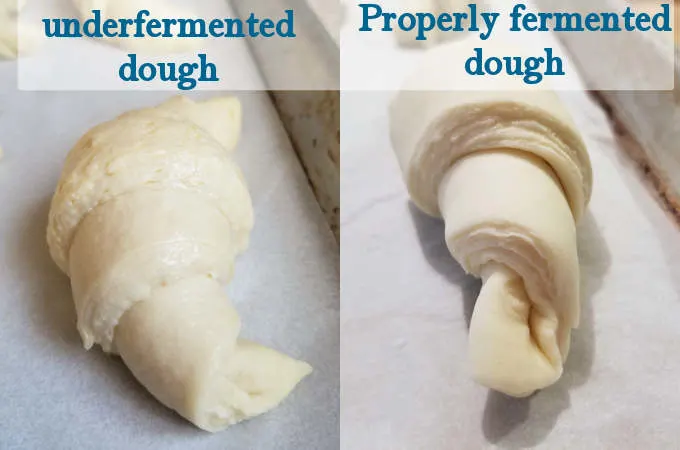Sourdough Croissants
These Sourdough Croissants are the best croissants ever! To have fresh Sourdough Croissants for breakfast, refrigerate them overnight and bake in the morning.

The difference between Classic Croissants and Sourdough Croissants is the use of the natural yeast in the starter to rise the dough. (You can use a smidge of commercial yeast to help you out, more on that later.)
If you don’t have one, check out my post to learn How to Make a Sourdough Starter. Then check out my system to Feed and Maintain Sourdough Starter. In the meantime you can go ahead and make those Classic Croissants with yeast.
I baked over 100 Sourdough Croissants before I was ready to post the recipe. The basic ingredients were not hard to nail down, I simply replaced some of the water and flour in the dough with sourdough starter and removed the yeast.


The biggest hurdle was keeping the dough warm enough to stay active, but not so warm that the buttery layers melt out of the dough. Well, that’s the challenge with any croissant recipe, but when working with sourdough is even more of a challenge.

What’s the secret to great Sourdough Croissants?
After several less than stellar batches, I finally decided that I had to treat this dough differently than classic croissant dough. Normally I would chill the dough after it’s mixed and chill it between each “turn”.
The problem with using that classic method is that each time I refrigerated the dough I slowed down the activity of the natural yeast and I could never get quite the poof I wanted in the final rise.
The first change I made was to add a hint of commercial yeast to the dough. Just a 1/2 teaspoon to help the dough stay active, but not so much that it would overtake the natural yeast or speed up the process too much. ***(See recipe note to make the recipe without commercial yeast.)
After 3 hours of fermentation the dough was beautifully soft, yet resilient. So I decided to skip the refrigeration step and move right into the lamination process.
Because the dough was soft, I let the butter warm up enough that it was a bit pliable, but still cool. This made it easier to roll the dough without the butter breaking apart.
Since the dough was so easy to work with I went right ahead and did the first two turns. I gave the dough a quick chill before the final turn and then a longer chill before rolling and cutting the dough.
Not only did this process cut a couple of hours from the total time, it also meant that my dough stayed nicely active. The dough was silky and alive. A good sourdough should feel alive in your hands.
The final step was to refrigerate the croissants overnight. In the morning I got up super early (the dogs help me here) and took the croissants out of the refrigerator.
Because my kitchen can be quite cool on a winter morning, I turned the oven on just for a minute to barely warm it up then turned it back off. (I wouldn’t need to do this in the summer.)
I put the trays in the oven and went back to bed (I’m not a morning person). When I got up a few hours later the croissants were ready to bake as soon as the oven was preheated.


Tips for making Sourdough Croissants:
- Your sourdough starter should be active when you mix the dough. It should pass the “float test”. Put a dollop of the active starter in water and it should float. If not, replenish your starter and wait until it’s active to mix the dough.
- If your kitchen is very cool, place the dough over a bowl of warm water or into a barely warmed oven during the fermentation time.
- If you find the butter is melting at any point during the lamination process, put in the the refrigerator briefly to chill.
- Brushing the dough with cool water before each fold helps create steam as the croissants bake. The steam will push the layers even higher for a bigger rise and flakier texture.
- The times in the recipe are estimates. The actual times will vary based on how active your starter is and the ambient temperature. The times will also be longer if you choose not to use the commercial yeast.

Over 100 croissants later, I can tell you that Sourdough Croissants have a depth of flavor that sets them apart from those made with commercial yeast. If you have a sourdough starter, I’m sure you know what I mean.
I know you hate to throw away that sourdough discard. Check out these recipes that use sourdough discard.
Are you a chocoholic? Me too. Use this dough to make decadent and delicious Chocolate Croissants. You’re welcome!
I’ve also got a recipe for almond lovers, Almond Filled Croissants are a little decadent and a lot delicious.
If you love this recipe as much as I do, I’d really appreciate a 5-star review.
Overnight Sourdough Croissants
Ingredients
- 8 oz active sourdough starter (1 cup, 100% hydration)
- 10 oz whole milk (1 ¼ cups, scalded and cooled to 110 °F)
- ½ teaspoon dry yeast (optional, see note)
- 17 ½ oz unbleached all purpose flour (3 ½ cups, see note)
- 3 oz granulated sugar (⅓ cup)
- 2 teaspoons table salt
- 16 oz unsalted butter (pliable but still cool)
- 1 egg (for egg wash)
Instructions
- Make sure your starter is active and bubbly before using. If not, refresh the starter and wait until it's fully active before mixing the dough. Place 8 oz active sourdough starter, 10 oz whole milk, ½ teaspoon dry yeast (if using) and 2 cups (10 oz) of the flour in the bowl of a stand mixer with the paddle attachment. Mix to form a thick batter. If working by hand mix with a wooden spoon. Cover the bowl and let it rest for 30 minutes.
- Switch to the dough hook. Add 3 oz granulated sugar, 2 teaspoons table salt and remaining flour. Mix until the dough gathers on the hook and clears the sides of the bow, about 3-5 minutes on medium speed. l. If working by hand stir in as much flour as you can with a wooden spoon, then finish kneading in the rest of the flour by hand.
- Transfer the dough to a lightly oiled bowl, turning once to coat the dough. Cover the bowl and set it aside at room temperature. After 30 minutes uncover the bowl, lift one side of the dough over into the middle of the dough. Repeat with the other three sides of the dough then flip the dough over. Cover the bowl and after 30 minutes repeat the procedure. Cover the bowl and after 60 minutes repeat the procedure. Cover the bowl and after 60 minutes repeat the procedure one last time. By now the dough should be lively, elastic and airy. If the dough is still sluggish give it another hour or two at room temperature.
- While the dough is fermenting, prepare the butter package. Draw an 8" square in the center of a piece of parchment paper. Flip the paper over and set 16 oz unsalted butter in the middle of the square. Fold the parchment over the butter. Use a rolling pin or other heavy object (I use the flat side of a meat tenderizer) to flatten the butter to fill the 8"x 8" square. You can lift the paper if it sticks. Trim and rearrange the edges of the butter as needed. Fold the butter into the parchment and place in the refrigerator. 30 minutes before the dough is finished fermenting, remove the butter from the refrigerator. (If your kitchen is very warm, take the butter out 10 minutes ahead.) The butter should be firm and cool but a little flexible for layering into the dough.
- Turn the dough out onto a lightly floured surface. Do not knead out the air. Roll the dough to a 10" square. Once you have a square, roll from each of the four sides to form a 3" flap of the dough, leaving the center thicker than the flaps. You should end up with a square with four "flaps" coming out from the corners. Now it’s time to layer in the butter.
- Unwrap the butter and place it in the middle of the square. Fold the flaps so they overlap and enclose the butter, pinching in the corners as necessary to glue the seams together. You should now have an 8" square of dough with the butter enclosed. Use the rolling pin to gently press on the square to flatten it. Roll the dough to a 8" x 24" rectangle. Take your time to roll gently and evenly so the butter stays in one layer in the dough.
- Orient the dough so the long side of the rectangle is facing you. Brush off the excess flour. Brush the entire surface of the dough with cold water. Fold the right 1/3 of the dough towards the middle then fold the left 1/3 of dough over enclosing it like a letter. This is the first "turn".
- Orient the dough so the closed edge is on the top side and the open edge is facing you. Roll the dough again to an 8" x 24" rectangle. Brush off the excess flour. Brush the entire surface of the dough with cold water and again fold the dough like a letter. This is the second "turn". Set the dough on a sheet pan, cover with plastic and refrigerate at least 30 minutes.
- Remove the dough from the refrigerator and do a third turn exactly like the first 2. Wrap the dough and place it in the refrigerator for at least 2 hours.
- Line 2 baking sheets with parchment paper or a silicone baking mat. Roll the chilled dough to a 24” long x 16” wide rectangle. With the long side facing you, fold the top half of the dough over the bottom half to form a 24” long x 8” wide rectangle.
- Starting from the left, measure along the top edge of the dough and make a mark at 2”. Using a pizza cutter or sharp knife, make a diagonal cut from that mark to the bottom left edge of the dough. Save the piece that you cut off.
- Working from left to right, measure and mark 4” increments along the bottom edge of the dough. Working from left to right, measure and mark 4” increments along the top edge of the dough. You should have a pattern of one top mark between two bottom marks. Starting from the top left, make a diagonal cut to the next mark on the bottom edge, forming a triangle. Then cut from the bottom to the next top mark. Continue this pattern to cut 11 alternating triangles and one 1/2 triangle end piece. Save the 1/2 triangle piece you cut from the end of the dough.
- Unfold the triangles and cut each in half along the joint so you have a total 22 triangles. Unfold the 1/2 triangle pieces which you cut from either end. Pinch them together to form 2 more triangles.
- To form a croissant, hold a triangle from the wide base in one hand and gently stretch the width a little. Set the dough on the work surface with the narrow end pointing towards you. Roll the croissant towards the pointed end, holding on to the tip and gently tugging as you roll. Bend either end of the croissant towards the middle to form the crescent shape.
- Set the croissants on the prepared baking sheets, 3” apart. You should fit a dozen croissants per half sheet pan. Cover with plastic wrap and set in the refrigerator overnight. (see note)
- In the morning. Take the croissants out of the refrigerator. Allow them to proof at room temperature for 2-3 hours. The exact time needed for proofing will vary depending how active your starter was and the temperature of your kitchen. They should be at least 50% larger than they started and feel airy and puffy. Preheat the oven to 400 °F. Brush the croissants with egg wash. Bake the croissants until golden brown, 15-20 minutes. Serve warm or room temperature.
Would you like to save this recipe?
As an Amazon Associate and member of other affiliate programs, I earn from qualifying purchases.









I am excited to try the recipe. Can these be frozen? If so, do I freeze before or after the last rise? Thanks!!!
I usually freeze the baked croissants then reheat then in a low oven to re-crisp. If you want to freeze them before baking I would put them in the freezer after shaping. They’ll need to defrost and rise before being baked.
@Eileen Gray, thanks!!
Hi Elieen,
In a few of your sourdough recipes you have suggested warming the dough in the oven briefly the following morning to kickstart the rise. Can I do that with croissants or will the mess up the butter layers?
First time making these and I am very excited!!
I’d be careful with the croissants since, yes, you might melt out the butter layers. It’s not impossible to do it, but I would just heat the oven until it’s BARELY warm and then put the pan in just long enough to take off the chill.
Second time around and it wasn’t a success on either tries. Although they did taste amazing.
The dough didn’t rise after 4 stretch and folds. Should I have let it sit until it doubled in size before i started the laminating process?
Everything went super well, expect that they didn’t rise after i rolled them.
Not sure what I did wrong.
The butter did not leak through and the dough didn’t break either. But it just didn’t rise even though i did the floating test with the starter.
If your dough wasn’t active before you started laminating it is difficult to get things going once you start laminating and chilling. I find in the cooler winter months the dough often needs extra time to get going.
A bit frustrated with this recipe as it does not specify in step one that you use SOME of the flour and not all. Probably won’t turn out now but I used all of my starter and can’t start over.
Step one says “Place the starter, milk, yeast (if using) and 2 cups of the flour in the bowl of a stand mixer”. It specifically tells you exactly how much flour to add. Not sure how much more explanatory I could be…
I’m starting these now, as I’ve been wanting to make croissants for a few weeks now and just realized today that I could probably use my sourdough discard in them – so this is perfect! One question, do you personally use the weights in your recipe or the volume measurements? I always bake by weight, but my conversions are significantly different than yours are, so I want to make sure I’m using the actual amount called for. (For instance, if I weigh out my equivalent of 3.5 cups of flour – by my weight conversion, that’s 420g or just shy of 15oz flour, significantly less than the weights you provided. So I don’t know whether to use 420g or the 490g you call for by weight. Same for the sugar – 1/3 cup to me is 67g or 2.3 oz.) Thanks so much! Looking forward to these! 🙂
Using weight measurements is the most accurate for the exact reason you are describing. The weight of a cup of flour is not an absolute since how you fill the cup can significantly change the actual amount of flour in the cup. I use the “dip and sweep” method for filling a measuring cup. That is, I “dip” the cup into the bin of flour and over fill it. Then I “sweep” away the excess flour for a level cup. Using that method I always get 5 oz of flour per cup and that is the conversion I use for my recipes. If you fluff the flour and then spoon it into the cup you can get as little as 4-4.5 oz per cup. Again, this is why weighing ingredients is always preferable for baking. Have fun!
@Katy, one point to note is that there is a difference in size between the original American cup and the UK equivalent. The other issue is about density of flour and the differences in weight per volume. You should probably stick to weighing the ingredients before sifting.
I baked these this morning and the recipe is perfect I made some mistakes and learned so much! In spite of my newness to this type of pastry, they are delicious. Thank You for the opportunity to try to make my own Croissants! I will make these again and with chocolate!
Great, here’s a post for Chocolate Croissants.
My croissant dough was very sticky and the butter ended up breaking through because it was impossible to roll out. I used almond and vegan butter. Do you know why my dough was so sticky and how I can fix it next time?
If you changed the ingredients it’s hard to figure out what went wrong. The butter could leak out if the dough is not fermented properly. You can see an example of this in the process photos.
@Eileen Gray, would it be possible to put the laminated dough in the fridge overnight and roll out in the morning?
Yes.
@Eileen Gray, I just finished up my third attempt and they turned out much better! Thank you for the recipe.
To freeze the croissants does it matter whether I proof the rolled croissants then freeze or do I freeze them immediately after rolling and then proof when I take them out of the freeze?
That’s great to hear.
@Eileen Gray, they looked and tasted great after they were baked. I did have an issue of a large amount butter leaking out out of the croissants. Do you think this was due to not fermenting the dough long enough or not letting them proof long enough after they were rolled. I fermented the dough for 3 hours and proofed the rolled croissants for 3 hours.
It’s hard to say. I generally do have some butter leaking out. During recipe testing I definitely got more butter leakage if I didn’t have a nicely fermented and stretchy dough.
@Eileen Gray, roughly how long do you knead the sourdough croissant dough for in your stand mixer and at what speed? Thanks!
About 3-5 minutes on medium speed.
Can you refrigerate the dough after making it? And for how long
Yes, once you’re done laminating the dough, you can wrap it tightly and refrigerate for 1-2 days. The take it out, cut and roll the croissants, rise and bake.
I am newer to sourdough baking and came across your recipe. I have always wanted to try croissants but have been intimidated to make them as I have always heard how hard they were to make them. Well I tried your recipe and they were a hit!! I made mine chocolate and rolled them up in rectangle like most chocolate croissants and got about 14 out of the dough. Everyone I gave one to absolutely loved them. Thank you so much for this recipe.
PS One thing I wasn’t 100% sure about after first long roll with butter was after you fold in thirds if you are suppose to turn side ways and roll out that way. Hard to say what I mean. Basically after rolling and folding in thirds do you turn dough sideway and both open ends become the length directions? I’m sorry I can’t explain this better. I did try to watch video to figure out but it wasn’t totally clear on I except maybe the final roll.
Thanks again for such a wonderful recipe.
I understand your question. In the recipe I specify to “Orient the dough so the closed edge is on the top side and the open edge is facing you” after the first fold. In other words, assuming you did as instructed in the previous step (Orient the dough so the long side of the rectangle is facing you) you will be turning the dough sideways so you are now rolling from the opposite direction. Oh, and I just published a recipe for Chocolate Croissants which an be made with the sourdough croissant dough.
I’m making this recipe for maybe the 5th time. I just noticed the scalded milk. Is that a recent change? I don’t remember doing that before.
Yes, I’ve started adding that step for all my bread recipes that have milk in them. Scalding the milk changes the whey protein. Whey protein can interfere with gluten development. The milk was always warmed up, I just made it explicit to scald the milk first.
I made these and it took forever! It’s Jan in the U.P and very cold and dry. So I started at 10am and got them rolled up at 2am! Put them in the oven this am and they are FANTASTIC! I’ll make them bigger next time.
Yes, sourdough can be slow in a cold kitchen. Sometimes I’ll put the dough (before laminating the butter) over a bowl of warm water to speed it up a little. Just make sure the bottom of the bowl doesn’t touch the water.
I’m in the middle of my second attempt at this. The first time came out great! This time I am doubling the recipe, and will make half the batch of chocolate croissants. Unfortunately, when I started I realized that I didn’t have enough starter, and had to wait several more hours to grow more starter. So I got a late start. I think I’m going to stop after step 9 and leave the laminated dough in the fridge overnight. I am hopeful this will work ok…
So I have a question – have you ever tried it with 4 turns instead of 3? Many (most?) other recipes I looked at use 4 turns. So 81 layers instead of 27. I’m wondering how that might change how they come out…
An extra turn should not be a problem.
Have you ever made chocolate croissants? If I wanted to add chocolate when should I do that?
You can definitely make chocolate croissants with this dough. I have used the little Ghirardelli squares that you can buy in the grocery store. Cut the square in half and stack the two pieces. Place the chocolate into the wide end of the croissant before rolling. If you can to be more authentic, you can buy chocolate batons on Amazon.
Hi Eileen,
Thank you for the recipe! Do you use active dry yeast or instant yeast?
Thanks again!
Whatever I happen to have on hand. Usually active dry.
Hi Eileen,
My office baking expert recommended your website and I am so thankful for the recommendation. I enjoyed going through your baking lessons one by one and I made your sourdough bread, pretzel, pita and hamburger buns. Thank you.
I tried to make the croissants this past weekend. My dough looked fabulous until lamination: I took the dough out of the fridge to roll it out and it was very tight, very firm and very springy. I was barely able to stretch it wide enough for my butter layer, and even then I stretched it out in the air like a pizza dough, instead of rolling it out. Rolling just didn’t work.
Needless to say, none of my lamination turns were easy. I wasn’t able to stretch it out for the last fold and I just folded it on itself with a sigh. I managed to cut and roll them in a dense croissant like shape but they didn’t proof at room temperature and unrolled in the oven. The layers looked great, but the dough didn’t have any spring to it, it rather looked like piles or flat, buttery vol-au-vent.
I used all purpose unbleached flour. I don’t know how old the flour was, could that have made a difference?
Any idea what else I could have done wrong?
Also if you are looking for a new challenge, I would love a sourdough vol-au-vent pastry recipe… 🙂 Cheers!
You said “I took the dough out of the fridge to roll it”… Did you refrigerate the dough before beginning lamination? I have better results when I go directly from fermentation to lamination. With the milk and sugar in it, this dough is usually pretty supple. Did you knead the dough after it was mixed? The recipe has you mix the dough just until it comes together without additional kneading. Unbleached ap flour is exactly what I use. Unless the flour is rancid, the age doesn’t matter. At any point in the process if the dough gets really springy a 30 minute rest in the fridge will give it some slack.
Hi,
I would love to try this recipe but I am vegan. Any success with vegan butter?
Thanks,
I personally don’t have experience using vegan butter, but here is a quote from a previous comment on this recipe “We are vegan, so we used soy milk and vegan butter for the dairy products and I used a oil wash instead of an egg wash. These are so good!”.
I’ve made these twice (well, I’m in the middle of the second time now). Both times I’ve found that as soon as I start rolling things out with the butter inside, the butter oozes out the edges and gets all over the rolling pin, all over the counter, all over my hands. After the first turn or two, as the layers of dough get thinner, it starts escaping from the middle of the sheet as well as the edges. Any suggestions as to what I’m doing wrong, or is this just what happens when you make croissants?
Some differences that might explain it: I’m using mostly bread flour (with a little whole-wheat), rather than all-purpose because I didn’t happen to have any all-purpose in the house. And I’m making a half batch, so the rolling measurements needed to be reduced, e.g. a 6″x6″ square rather than 8″x8″. Is halving the recipe just a doomed exercise?
Start with butter that is chilled enough that it is firm but is slightly pliable. If your butter is oozing it must be too warm.
Followed this recipe and they came out PERFECT! Drizzled some chocolate on a few and they were so yummy!
Hello Eileen,
I have only recently been experimenting with sourdough recipes.
The problem I had was that the croissant collapsed after coming out of the oven. Still taste good though
A lot of butter oozed out during cooking and they feel quite heavy and doughy..
Any suggestions?
Many thanks
Sandra (UK)
It’s possible that your dough was not properly fermented. If you scroll through the post and look at the photos you’ll see a photo showing side-by-side comparison of under-ermented and properly fermented dough.
Hi eileen, I cannot seem to find your video on making sourdough croissants on your page. Can you assist? I am feeling challenged following through the instructions from step 4 onwards and would very much appreciate a video to guide me through. Thank you! 🙂
If you’re running an ad blocker the video won’t play. If you turn off the ad blocker the video player will show.
I tried these today, but they didn’t quite turn out right. The flavor was great, but I didn’t wait long enough for the final rise, after taking them out of the fridge, so that was my fault. My dough did great, rise-wise, throughout the entire process prior to that…it was nice and billowy and soft, yet resistant. I also used bread flour instead of all purpose. Do you think that would effect things. Or, was more simply because I was impatient when it came to the final rise? They didn’t really double, and I could tell with the result that I messed up by not waiting longer =( Anyway, I’m still wondering if you think using bread flour would work, if I actually did what I was supposed to and waited for the proper rise at the end 😉
Also, when I did the laminated, the butter didn’t exactly melt; but, it did soften some and ooze out the edges of the dough a little when I was rolling it into a rectangle. Is that supposed to happen?
The biggest difference with bread flour is not only that you’ll get more gluten, but bread flour also absorbs more moisture so the dough will be drier. That being said, using bread flour shouldn’t ruin the croissants. It probably made the dough harder to roll since it will tend to spring back more. It also may make it hard to keep the butter in if the dough wants to continually snap back.
I will say that having made these croissant many times, that final rise can seem to take forever. I set the alarm for super-early, like 4 or 5 am, take them out of the fridge and go back to bed for a few hours. I’ve had some readers tell me they’ve been leaving their recipes out on the counter overnight rather than in the fridge. If your kitchen is cool that can work. That might be a problem in the warmer months.
If your butter softened and oozed during the laminating process that could compromise the layers as the croissants bake. (Combined with extra spingy dough too.) As I mention in the “tips” section of the post, if the butter softens at any time return the dough to the fridge to chill before proceeding. The butter should be slightly pliable but still cool when you start the process.
What did the final croissants look like? Were then just a little under-risen or did they not have all the distinct layers inside? My feeling is that the oozing butter may have been your biggest issue.
Hi!! Is it possible to not use osmotolerant instant yeast?? just WILD YEAST from the STARTER??? 🙂 or what should I use instead?
You can make the dough without commercial yeast, you’ll just have to be patient with the fermentation and rising times. Make the dough when your starter is really active to give it a head start. I haven’t made these recently, but I need to give them another try without commercial yeast to nail down the timing. If you try it, let us know how it goes.
Edited to add: I just made this recipe again without any commercial yeast, and it worked just fine. I’ll update the post with details, but you do just have to be a bit more patient, especially with the long fermentation on the first day. It also took a bit longer for the croissant to rise in the morning, but it is workable. Thanks for spurring me on to continue working on the recipe!
Hi Eileen! I made these last week and they were awesome! I froze half the batch and want to make them this weekend. Is it better to take them out the day before and defrost them in the fridge or take them out the night before and defrost them at room temperature so they’re ready to bake in the morning? Love your recipes! Thanks.
I would take them out and defrost them at room temp. I find that if something is frozen solid they don’t quite defrost in the fridge overnight. Let me know how they do. I usually freeze them after baking.
Hi Eileen
Quick question as I’m going to make these today, in your notes below the recipe you talk about freezing before baking then defrosting, proving and baking. But in your comment above you say you bake then freeze. Which do you recommend?
I’ve done both. Personally, I prefer to bake them and then freeze for the convenience. As long as you give them a couple of minutes in the oven to warm up there as good as fresh-baked.
Hi Eileen,
Thank you so much for sharing this recipe. I’m from Brazil, and here we use celsius to measure temperature. So, when you say 110° for the milk, is it in Farenheit ou Celsius?
Thanks again
Hi Carolina, all the temperatures listed in my recipes are Fahrenheit. Thanks for asking.
Thank you so much for sharing your recipe. I made a half batch and I was not keeping my hopes up bc the recipe had many steps and I didn’t get the timing right. I had to give the dough a lot of breaks since I had things to do. But they actually turned out!!! I’m trying the bagels next which seem much less complicated. 🙂
Yes, there are a lot of steps for making croissants. Nothing difficult, just a lot of steps.
Hi, I love sourdough! I bake everyday and make all different types of sourdough products. The one recipe I was looking for was croissants and then I came across your site. I have made these croissants 2x with slight modifications. My husband and children loved them! We are vegan, so we used soy milk and vegan butter for the dairy products and I used a oil wash instead of an egg wash. These are so good! We are now going to make your english muffins. Thank you so much for all of your hard work writing up these recipes and trying them out in your kitchen first. So much appreciated!
Thanks so much for the feedback Michele. If you haven’t tried them yet, I highly recommend the Sourdough Donuts!
Eileen,
I am interested in trying your recipe, as I am currently experimenting with sourdough croissants. I have a question regarding the actual hydration rate of the recipe. In one of the comments above, you state that it is around 57%, but my calculation show a value of 68%. The total flour content is 602g (490g flour + 112g flour in the sourdough starter) while the liquid content is 412g (300g milk + 112g water in the sourdough starter). I therefore have a hydration rate of 412/602, that is 68%. This is a much higher value than in any other croissant recipe (sourdough or not) I have seen. For instance, the current recipe I follow has 56% hydration, which is pretty typical. Is your recipe Indeed as hydrated as my calculation show or is there a mistake in the flour/liquid quantities? The posted video shows a dough that certainly looks more hydrated than the one I currently work with, but I want to be sure that I have everything right before I try your recipe. Thank you for clarifying.
Hi Frank, The whole milk in the recipe is about 87% water, not 100%. So my calculation is total flour 602g and total water is 355g (112g from starter and 243g from milk). 355/602 = 58%.
Eileen,
thank you for responding so fast! Regarding the whole milk quantity, 87% of 300g is 261g, so it seems that the total water content of the recipe is actually 373g (261 + 112), not 355g. This results in a hydration rate of 373/602 = 62%. This seems consistent with your dough looking more hydrated than mine without looking super wet. Am I correct?
If working by weight (milliliter is a volume measure) I use a conversion of 28g per ounce. 10 oz of milk would be 280g. 280x.87=243. Also, as far as the texture of the dough, don’t forget to consider the sugar. Depending on how much sugar is in your recipe that could account for a textural difference too.
Eileen,
I apologize for being picky, but the 1 1/4 cup (10 oz) of whole milk in the recipe weighs much more than 280g. 1 1/4 cup of water (10 oz or 300 ml) weighs exactly 300g, but milk has a higher density than water so the weight for the corresponding volume of milk is actually around 302g, Please check the following site for actual measurements:
This means that the actual hydration rate for your recipe has to be closer to 62% than to 58%. I have to get it right in order to try replicating your very nice croissants. Anyway, I’ll give it a shot based on this 62% hydration rate guesstimate and will let you know how it goes. Thank you!
Ok.
Calculating the hydration rate would have no influence on the recipe itself. Why did you say you had to know exactly the hydration rate so that you could try to make them?? That makes no sense?? You sound like you just wanted to correct her for no other reason than you want to be right.
Hello Eileen, and thank you very much for this wonderful recipe, I’d been looking for the recipe of sourdough Croissants for quite a while, then came across yours and realized that for the first time I am not questioning the method. Baked them today, and very happy with the result. One question though: the dough came out pretty dense (granted, I am a tartine person and would rather work with high hydration dough). Used KA all purpose flour. Is it supposed to be dense? Should I add a bit more milk next time (and there will be next time, definitely)? Thank you very much!
Did you work by weight or by volume measure? I also use KA all purpose flour. If you watch the video you can get a sense for the texture of the dough. It becomes lighter as it ferments, but I wouldn’t call it a “dense” dough. As you know there are variables based on how active your starter is, the hydration of your starter (I replenish my starter with equal weight water/flour so it’s 100% hydration). If you look strictly at the milk and flour in the recipe, it’s about 57% hydration, which is less than the 75% you’ll see in a Tartine recipe. But there is also sugar in the dough, which is a tenderizer. I find super high hydration dough a bit harder to work with and with the lamination process I prefer to have a less wet dough. I’m pretty happy with the texture, but you could certainly experiment with adding a bit more milk. If you do, let me know how it works out. I love to hear about recipe testing.
Thank you for the quick reply. I went by volume though normally would go by weight. I keep my starter at 50% hydration, but for the croissants I fed 40 g of starter with 100 ml of water and 100 g of flour and kept it overnight on the counter. I guess next time I will increase the hydration of the starter to get it to 100% and weight ingredients. Might get away without adding more milk. Will definitely let you know the outcome.
Eileen, Can these be made without sourdough starter? If so, how does the recipe differ. I assume the technique remains the same. Thanks.
Hi Judy. You can replace the 8 oz of starter with 4 oz of water and 4 oz of flour and increase the yeast to 1 packet. The timing will be a bit different since a dough made with commercial yeast will work faster. Instead of a 3 hour fermentation, just let the dough rise until doubled. You can still allow the formed croissants to rise over night in the refrigerator, but they may rise a little faster in the morning.